

Liverpool Agility Model - online Tool. HBR's 10 Must Reads on Business Model Innovation (2019) by Harvard Business Review. The Symphini OutPerform Model. “OutPerform” means to surpass one’s personal best, to surpass one’s competition.
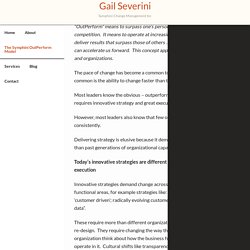
It means to operate at increasingly higher levels … levels that deliver results that surpass those of others … levels that deliver results that can accelerate us forward. This concept applies to individuals, leaders, teams and organizations. The pace of change has become a common topic. However, what is not common is the ability to change faster than the competition.
Most leaders know the obvious – outperforming the competition requires innovative strategy and great execution. However, most leaders also know that few organizations deliver these results consistently. Delivering strategy is elusive because it demands different ways of operating than past generations of organizational capability. "Enterprise Systems and Organizational Agility-A Review of the Literature and Conceptual Framework" by thao phuong trinh, Alemayehu Molla et al. Abstract The impact of enterprise systems (ES) on organizational agility (OA) is an under-researched area.
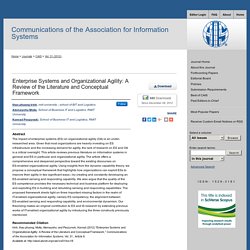
The five trademarks of agile organizations. This article was written collaboratively by the McKinsey Agile Tribe, a group of over 50 global colleagues bringing expertise from the digital, operations, marketing, and organization disciplines.

They integrate their deep experience and thought leadership to extract the best from McKinsey’s global experience as it helps organizations transform themselves into agile organizations. Our experience and research demonstrate that successful agile organizations consistently exhibit the five trademarks described in this article. The trademarks include a network of teams within a people-centered culture that operates in rapid learning and fast decision cycles which are enabled by technology, and a common purpose that co-creates value for all stakeholders. These trademarks complement the findings from “How to create an agile organization.” The old paradigm: Organizations as machines A view of the world—a paradigm—will endure until it cannot explain new evidence. First, the old paradigm. 1. 2. 3. Activate agility: get these five things right.
– by Christopher Handscomb and Shail Thaker In a time of rapid change and unprecedented complexity, only the nimble survive!
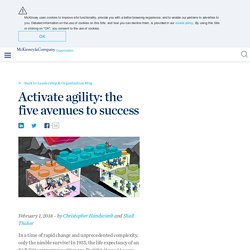
In 1935, the life expectancy of an S&P 500 company was 90 years. By 2010, it was 14 years and studies show that it’s getting even shorter. No wonder more and more companies, who are tired of change fatigue and endless restructuring, are looking at how they can become a more agile organization and retain their competitive advantage. Five Fifty: This year’s model. Agility Consulting. Agility Consulting and Training has identified five characteristics needed for organizations to be capable of anticipating and responding to changing demands and adapting to new requirements . . . in real time.

The Agile Model® provides a roadmap to help organizations and leaders navigate through the turbulent waters of today’s business environment. The Agile Model® is built from best practices in organizational performance and is endorsed by the American Management Association (AMA). Using the speedbumps technique to foster organizational agility. Sustainable Organizational Agility Transformation Approaches. Burke-Litwin: Understanding Drivers for Change. A Review of Enterprise Agility Concepts, Frameworks and Attributes. International Journal of Industrial Ergonomics.
Figure 6.1 – What Your Most Agile and Engaged Employees Should Be Thinking. Figure 5.1 – Steps to Creating a Powerful Ecosystem Questions to Ask. Focus Findings - The agile organisation. The agile organisation Is your organisation fit or lazy?

The ability to quickly adapt to changing environments stands as the single most important tool to succeed and ‘fight the flab’. In studying more agile global and local organisations up close, we have compiled eight characteristics that we believe underpin organisational agility. This is based on our observations of successful organisations and continuous research on organisational effectiveness. The eight building to organisational agility - Hay Group. Development of the Organizational Agility Maturity Model - Roy Wendler. Amanda Setili - The Agility Advantage: How to Identify and Act on Opportunities in a Fast-Changing World. Preface ix 1 What Is Agility—and Why Is It Valuable?

1 2 See Through Your Customers’ Eyes: How to See What Your Competitor Can’t 21 3 Right Customers, Right Value, Right Time: Identify Your Most Attractive Customers and Pivot with Them 43. McKinsey - Agility: It rhymes with stability. Companies can become more agile by designing their organizations both to drive speed and create stability.
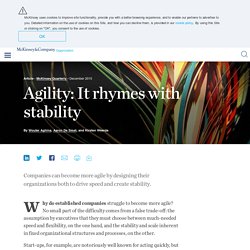
Why do established companies struggle to become more agile? No small part of the difficulty comes from a false trade-off: the assumption by executives that they must choose between much-needed speed and flexibility, on the one hand, and the stability and scale inherent in fixed organizational structures and processes, on the other. Start-ups, for example, are notoriously well known for acting quickly, but once they grow beyond a certain point they struggle to maintain that early momentum. Equally, large and established companies often become bureaucratic because the rules, policies, and management layers developed to capture economies of scale ultimately hamper their ability to move fast. John Kotter - Accelerate! Perhaps the greatest challenge business leaders face today is how to stay competitive amid constant turbulence and disruption.
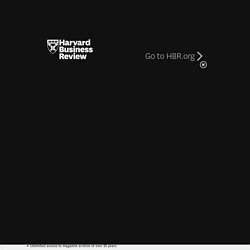
Any company that has made it past the start-up stage is optimized for efficiency rather than for strategic agility—the ability to capitalize on opportunities and dodge threats with speed and assurance. I could give you 100 examples of companies that, like Borders and RIM, recognized the need for a big strategic move but couldn’t pull themselves together to make it and ended up sitting by as nimbler competitors ate their lunch. The examples always play out the same way: An organization that’s facing a real threat or eyeing a new opportunity tries—and fails—to cram through some sort of major transformation using a change process that worked in the past.
But the old ways of setting and implementing strategy are failing us. We can’t keep up with the pace of change, let alone get ahead of it. Boston Consulting Group - Adaptive Advantage. Hay Group - Focus 2013.